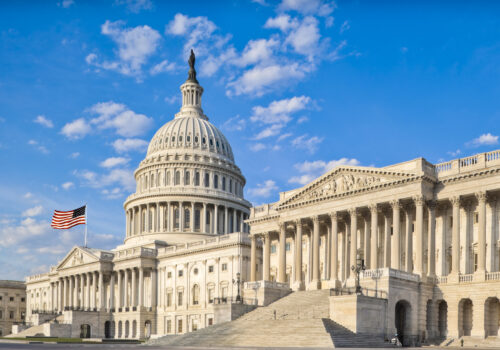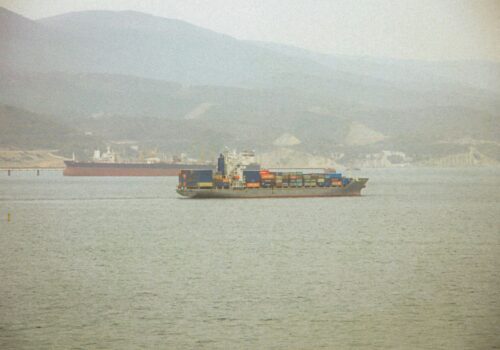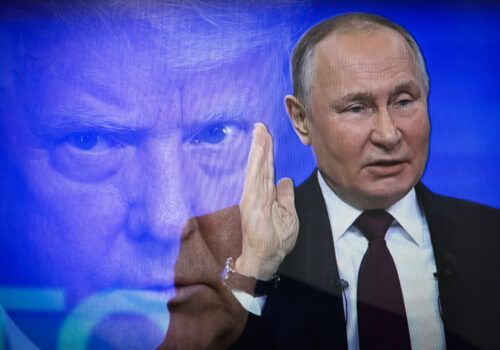Why the US should not lift sanctions against Russia
Today marks the third anniversary of the unprecedented package of Group of Seven (G7) sanctions deployed against Russia following the launch of its full-scale invasion of Ukraine. To the surprise of many, the anniversary coincides with musings by the new Trump administration on “normalizing” relations with Moscow. This normalization would come with “future cooperation . . . on historic economic and investment opportunities,” which would supposedly require the lifting of sanctions.
It’s true that the power of sanctions was oversold by some Western commentators and officials at the beginning of the war, particularly when it was hoped that they might force Moscow to change course.
In reality, once it became clear that the shock of bold measures like the immobilization of Russia’s reserves weren’t going to cause a domestic financial crisis, the aim of the sanctions shifted. Since then, the sanctions have been part of a long-term effort to erode Russia’s ability to sustain its war economy by depriving it of income through import bans and the oil price cap—which has had mediocre results since it was implemented in in December 2022—and depriving it of technology and resources through export controls.
While Moscow has found ways to mitigate the impact of these measures, growing deficits, unsustainable subsidies, and the rising cost of debt servicing show that economic pressure is still working. Removing restrictions without significant concessions risks emboldening not only Russia but also other states contemplating economic and military aggression.
The argument now for strategic patience—for keeping sanctions on Russia in place—is not just a convenient excuse for the lack of immediate results. It reflects a deeper reality about how economic pressure works over time.
Russia’s economy has grown each year since its full-scale invasion. But since 2023, this has mainly been because of increased government spending, which is changing the structure of Russia’s economy and making entire sectors more reliant on the war. Once French auto producer Renault left Russia in the aftermath of the full-scale invasion, the plants of firms it partnered with in the country were requisitioned.
Moscow has had several levers at its disposal to manage the fiscal effects of an economy increasingly propped up by the government. Special quarterly and annual taxes on oil-and-gas and non-oil-and-gas income have allowed the Kremlin to capture additional revenue as prices have fluctuated (mainly upwards). War spending has shrunk the share of oil and gas in Russia’s gross domestic product (GDP) and the share of oil-and-gas taxation in the overall tax take. The latter has moved from 35.8 percent before the war to 41.6 percent in the bumper year of 2022, when prices spiked in response to the war, to a predicted 27 percent in 2025. The government still makes regular deposits into Russia’s National Wealth Fund, but these no longer follow a predictable rule with a cutoff oil price above which the income delta is saved. The fund has little visibility into its own future and can merely try to slow the pace of the exhaustion of its holdings.
Growing deficits still represent a risk. Russia is cut off from international lending and can therefore only reach into its rainy-day fund or issue more domestic bonds. As the chart below shows, the government’s withdrawals from the National Wealth Fund do not cover annual deficits entirely. But every year since the full-scale invasion started, Moscow has been forced to withdraw more than the budget law it tends to publish just a few weeks earlier suggests it will. The bills for many Russian public agencies and subsidies accumulate in December, just as economic activity slows down for the holiday season.
In dollar terms, the liquid part of the National Wealth Fund, which was estimated to be worth $112.7 billion out of a total $200 billion before the war, is running out. For most of 2023 and 2024, the weak ruble slowed the fund’s decline because non-ruble assets could be converted more favorably. But the ruble’s recent appreciation on the back of market sentiment around a “deal” means the withdrawals will hit the fund’s dollar value faster. If the 2024 rate of withdrawal from the fund’s current dollar value is used, and if one assumes few liquid assets have been sold so far, then the government can only rely on its liquid savings for another one to two years.
It’s important to note that Russia’s nonliquid assets aren’t all immobilized and can still be sold. This might include its shares in state banks or the national airline, Aeroflot, which needed an emergency capital injection from the fund in 2022. And while they aren’t meant to be used for government spending, the reserves that the Central Bank of Russia still has access to could also be used to plug future deficits. This would be interpreted as a very negative signal for price stability, however, and could result in already high inflation expectations climbing further.
What stands out in early 2025 is that, after a predictably costly December, the Russian government’s spending in January was also markedly above trend, at half a trillion rubles ($5.77 billion) for that month alone. This is the sort of result sanctions policymakers are happy to present, but it is important to look beyond one bad month. In spring 2023, for example, Russia’s year-to-date deficit was already 17 percent above the deficit planned for the whole year. But the government still managed to pull in more oil and gas income later and finish the year with a more manageable deficit, which measured below 2 percent of GDP.
In January, historian Craig Kennedy’s much-publicized research showed that Moscow was also relying heavily on concessionary loans to the military-industrial complex. This allows more funds to be channeled to the war effort without appearing as defense or “classified” items in the state budget—which both increased greatly in 2022. The explosion of credit in the Russian economy, despite a high interest rate environment, is indeed striking, and it is clear that this credit is disproportionately being directed to firms that are supporting the war effort.
However, it is more challenging to identify when the centrally planned credit boom will come back to haunt the government. Since the beginning of the full-scale invasion, the credit market has seen a major shift from short-term loans in favor of long-term loans lasting more than a year. Were the loans not being kicked into the long grass, the low rate of nonperforming loans might already be increasing.
With the limited information available to observers outside Russia, the country’s banks appear well capitalized for now and high interest rates are helping convince Russians to keep their cash in the financial system. But even without deep insight into the liabilities taken on by Russian banks, one can see that the aggressive loan policy is already hampering efforts to cut inflation and even pushing up the deficit.
Why? Since high interest rates are a deterrent from taking on more debt, the government has had to increase its subsidies to help banks keep lending at preferential rates. Russian banks are lending first to households, but heavy industry represents the second, growing category at the expense of farming. These are costing the government more every year and becoming another deficit-driving liability, like inflation. These liabilities not only force the government to increase salaries, pensions, and other social payments, but also pressure the Central Bank to keep interest rates—and therefore government borrowing costs—high.
In 2025, Russia’s planned federal budget expenditures on debt servicing will amount to 3.2 trillion rubles ($37 billion), which is nearly 40 percent higher than the plan for 2024, and 2.1 times higher than in 2023. Despite this, the actual government debt itself is growing at a much slower pace, with an expected increase of 38 percent by the end of 2025 compared to 2023.
Sanctions are having an unmistakable effect, albeit below the inflated expectations of many in the West in early 2022. Lifting sanctions now would provide relief to a system that is showing clear signs of stress. It would also be a signal to third countries currently on the fence about selling to Russia that they can get away with what they’ve stopped short of doing so far. Since the sanctions were put in place, China has not lent money to the Russian state, and Chinese banks are reticent to enter the Russian market for fear of US secondary sanctions. Will they be so reticent now?
Rather than lifting sanctions prematurely, policymakers should focus on closing loopholes, tightening enforcement, and maintaining coordination among allies. A premature retreat would weaken US leverage and embolden the axis of authoritarian regimes that are already helping each other circumvent Western policies, as my colleague Kim Donovan detailed in her testimony last week before the US-China Economic and Security Review Commission.
The question is not whether sanctions worked instantly, but whether the world can afford the long-term consequences of abandoning them too soon.
Charles Lichfield is the deputy director and C. Boyden Gray senior fellow of the Atlantic Council’s GeoEconomics Center.
Further reading
Fri, Feb 21, 2025
Kimberly Donovan testifies to the US-China Economic and Security Review Commission on the Axis of Autocracy
Testimony By Kimberly Donovan
On February 20, Economic Statecraft Initiative Director Kimberly Donovan testified to the US-China Economic and Security Review Commission at a hearing titled, "An Axis of Autocracy? China's Relations with Russia, Iran, and North Korea."
Mon, Feb 24, 2025
US energy dominance is Putin’s worst nightmare as Russia enters its fourth year of war crimes
EnergySource By Olga Khakova, Haley Nelson
Three years of Russia’s senseless aggression in Ukraine have caused monumental, unnecessary human suffering but also an irreversible impact on Russia’s energy sector. Sanctioning Russian LNG at the source is the most effective way to prevent future supply blackmail from Moscow.
Tue, Feb 25, 2025
Will a new Russia reset prove more successful than earlier attempts?
UkraineAlert By
The Trump administration is seeking to reset relations with Russia as part of a comprehensive shift in US foreign policy, but successive past Russia resets have ended in failure, writes Leah Nodvin.
Image: People walk past a board displaying currency exchange rates of the U.S. dollar and Euro against Russian rouble in Moscow, Russia November 27, 2024. Picture taken using a tilt-shift lens. REUTERS/Maxim Shemetov


